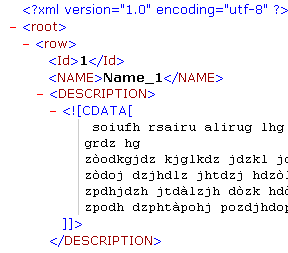Encoding:
The encoding of your XmlFile file like:
<?xml version="1.0" encoding="utf-8" ?>
Create on:
You can define which event on the page start the create the Xml file.
The value can be:
| On Page Load | on the OnLoad event of the page |
Post variable
| when the request.form variable exists |
Get variable
| when the request.querystring variable exists |
Session variable
| when the session variable exists |
Cookie variable
| when the request.Cookie variable exists |
With this variuos event you can define when the RssFeed is created, but the most simple method is create a link in your pages that point to a page where you insert only this extension and that create the RssFeed on the OnLoad event so when your user click on the link a new browser window is open and the RssFeed is created and displayed in the browser window.
Export method:
the method to display the Rss Feed, can be:
Browser: display the RssFeed inside the browser window
File: force the download of the RssFeed file and display the SaveAs popup window, so the user can save the RssFeed file on it's Pc.
File name:
The file name in case you setup the Export Method to file
All records:
If checked the extension create the RssFeed with all the records in the recordset, otherwise you can specify a number of record, this can be used to test the page and create a small Rss Feed file only for test or to limit the number of element in the RssFeed file.
Export as:
The Xml has 2 method to define value inside a node.
The Node Value and the Node Attribute.
This is an example of Node Value
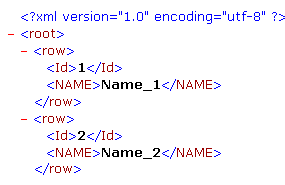
This is an example of Node Attribute

Xml root label:
The label of the first level node, like:
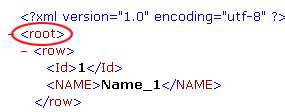
Xml row label:
The label of the node that will contain the data, like:
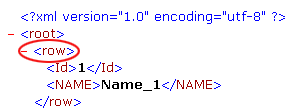
Recordset panel
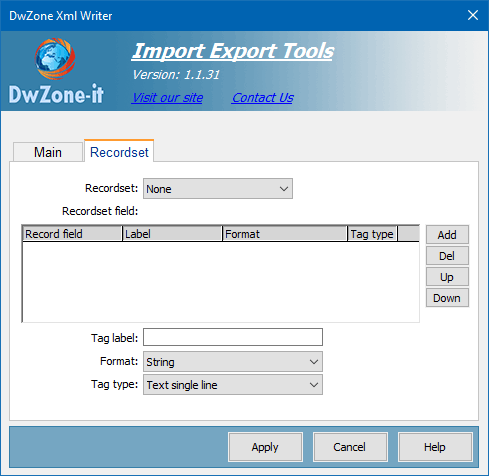
Recordset:
In the options Recordset pop-up menu, select the recordset you want to use as a content source.
Recordset fields:
After you select a recordset this element display the list of recordset field with a predefined label, format and tag type.
It's possible personalize all this parameters like you need, you must select a record field in this element and in the 3 element belowe you can modify the label, the format and the tag type for each record field.
With the 4 button in the right you can remove (Del button) the field you don't want export or add (Add button) a field you have deleted and setup the order position for each field with the button Up and Down button.
Tag label :
The label for the Tag or for the Attribute that will contain the field data.
Format:
The format of the exported data.
The available format are:
String
Number (Default)
Number (0 decimal)
Number (1 decimal)
Number (2 decimal)
Number (3 decimal)
Number (4 decimal)
Date DD.MM.YYYY
Date DD.MM.YYYY h:m
Date DD.MM.YYYY h:m:s
Date MM.DD.YYYY
Date MM.DD.YYYY h:m
Date MM.DD.YYYY h:m:s
Date YYYY.MM.DD
Date YYYY.MM.DD h:m
Date YYYY.MM.DD h:m:s
Date DD/MM/YYYY
Date DD/MM/YYYY h:m
Date DD/MM/YYYY h:m:s
Date MM/DD/YYYY
Date MM/DD/YYYY h:m
Date MM/DD/YYYY h:m:s
Date YYYY/MM/DD
Date YYYY/MM/DD h:m
Date YYYY/MM/DD h:m:s
Date DD-MM-YYYY
Date DD-MM-YYYY h:m
Date DD-MM-YYYY h:m:s
Date MM-DD-YYYY
Date MM-DD-YYYY h:m
Date MM-DD-YYYY h:m:s
Date YYYY-MM-DD
Date YYYY-MM-DD h:m
Date YYYY-MM-DD h:m:s
Boolean (true/false)
Boolean (1/0)
Boolean (-1/0)
Boolean (yes/no)
Boolean (Y/N)
Tag type:
This option is available only for Nodes export method, the attribute export method have only the SingleLine tag type available.
There are 2 type of tag. The SimpleLine and the MultiLine tag.
In this image you can see the 2 type of tag, the DESCRIPTION is a MultiLine tag and the NAME is a SingleLine Tag.
A MultiLine tag can contain also special char like the Html tag and text with LineFeed.
